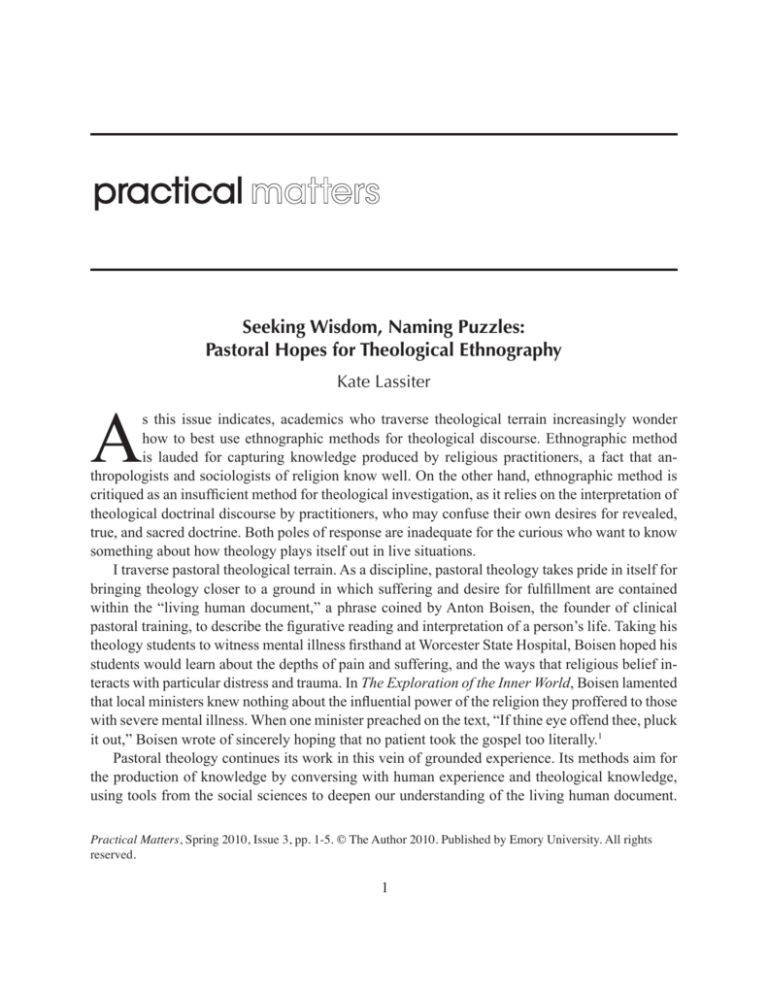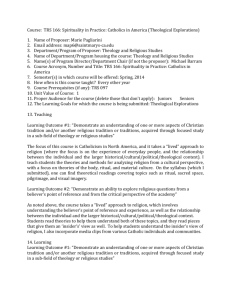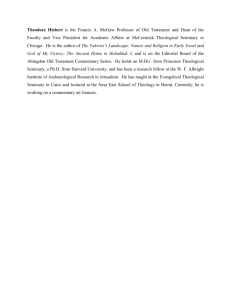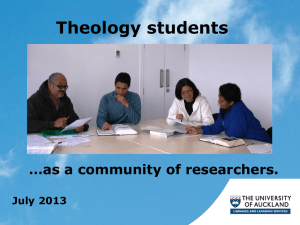
Seeking Wisdom, Naming Puzzles:
Pastoral Hopes for Theological Ethnography
A
Kate Lassiter
s this issue indicates, academics who traverse theological terrain increasingly wonder
how to best use ethnographic methods for theological discourse. Ethnographic method
is lauded for capturing knowledge produced by religious practitioners, a fact that anthropologists and sociologists of religion know well. On the other hand, ethnographic method is
critiqued as an insufficient method for theological investigation, as it relies on the interpretation of
theological doctrinal discourse by practitioners, who may confuse their own desires for revealed,
true, and sacred doctrine. Both poles of response are inadequate for the curious who want to know
something about how theology plays itself out in live situations.
I traverse pastoral theological terrain. As a discipline, pastoral theology takes pride in itself for
bringing theology closer to a ground in which suffering and desire for fulfillment are contained
within the “living human document,” a phrase coined by Anton Boisen, the founder of clinical
pastoral training, to describe the figurative reading and interpretation of a person’s life. Taking his
theology students to witness mental illness firsthand at Worcester State Hospital, Boisen hoped his
students would learn about the depths of pain and suffering, and the ways that religious belief interacts with particular distress and trauma. In The Exploration of the Inner World, Boisen lamented
that local ministers knew nothing about the influential power of the religion they proffered to those
with severe mental illness. When one minister preached on the text, “If thine eye offend thee, pluck
it out,” Boisen wrote of sincerely hoping that no patient took the gospel too literally.1
Pastoral theology continues its work in this vein of grounded experience. Its methods aim for
the production of knowledge by conversing with human experience and theological knowledge,
using tools from the social sciences to deepen our understanding of the living human document.
Practical Matters, Spring 2010, Issue 3, pp. 1-5. © The Author 2010. Published by Emory University. All rights
reserved.
1
Lassiter, Seeking Wisdom, Naming Puzzles
Practical Matters
Reflection on pastoral theological method has, historically, been derived from one-on-one encounters in the counseling room or the private ministerial consultation. However, ethnographic
methods like participant observation, document analysis, questionnaire, survey, and interview are
not completely foreign to it. One overarching goal of pastoral theological method is to equip those
preparing for ministry with the knowledge and experience necessary to navigate encounters of
grief and anguish, and of joy and hope. I, too, desire wisdom on these things, and I turned to ethnographic interview as one form of capturing this knowledge.
An encounter with an Episcopalian minister had stirred deep waters in my thinking about
teaching ministers-in-training about practices of care. He described a moral and theological conflict he encountered in ministry: a woman gave birth to a stillborn fetus. She asked for her daughter
to be named and baptized. The minister was conflicted. In one voice he heard his sacraments professor: “Baptism is for the living, not for the dead.” In another voice he heard his pastoral care professor: “The sacraments are not ours to withhold.” His dilemma became a theological problem to
be researched and understood, namely, how do professional ministers decide what kind of pastoral
care to offer to persons seeking care, particularly if the care requested conflicts with a theological
principle of the faith tradition that recognizes and approves the minister for ministry?
Reflecting upon this minister’s dilemma, I sought counsel on this question from journals, books,
professional associations, and church statements. The answers they gave were of two types: “Give
the patient what s/he requests” or “Be dutiful to your ordained office and follow doctrinal teaching.” I could not find resources that adequately described how a minister, particularly one working
in a diverse, pluralistic setting of faiths and traditions, might reason through his or her decision.
This question is an epistemological question; it could be answered on a philosophical and discursive level. However, philosophical and discursive-level answers, while providing great insight,
were insufficient to capture an emotional knowledge, a sense of timing, and the practical wisdom
that practitioners of ministry employ. Seeking further counsel on this question from practicing
fonts of wisdom, I submitted a pilot study application to the university’s Institutional Review
Board (IRB) for approval to examine this process. I submit to the gentle reader a portion below to
demystify the application.
Pastoral care is both a central task of, and an artful practice by, professional ministers.
Actions that convey pastoral care may take many forms, including non-anxious presence
and active listening (described as therapeutic pastoral care) and/or ritual performance that
marks the life cycle, often in the form of the sacraments. My research question broadly
asks, “What are the theological principles which undergird the form of pastoral care a
minister provides?” This question often surfaces in journals of ministry, particularly those
that educate on clinical pastoral education, but the articles are reflective of a practitioner’s
experience and do not seek to answer the question of process (or how one decides which
theological principles to employ) in the practice of pastoral care. Rather, they use the case
study as the primary form of research, and so reflect upon the “what” of pastoral care in
specific situations without globalizing the “how” or “why.”
2
Lassiter, Seeking Wisdom, Naming Puzzles
Practical Matters
Often professional ministers encounter requests for sacramental care, for example, baptism,
which conflict with the theological concepts that they have been taught in their theological
training for ministry, particularly when the care recipient perceives the situation to be one
of crisis. One critical situation often described by ministers in the relevant literature is the
request to baptize a stillborn fetus. Ministers describe a conflict between providing pastoral
care, in this case acknowledging the child as a person through the ritual of baptism in
which a child is named, and doctrinal sacramental theology, which proposes that baptism is
only for the living. Elaine Ramshaw, in Ritual and Pastoral Care (1987), briefly describes
this common situation, identifying two theological modes of care, the therapeutic and the
symbolic-ritualistic. She does not explain whether ministers hold these two dimensions
in a creative dialectic or whether it is possible that ministers may collapse the modalities.
How, then, do professional ministers decide what kind of pastoral care to offer to
persons seeking pastoral care, particularly if the care requested conflicts with theological
principle(s) of the faith tradition that recognizes the minister? The answers to this question
frame the three purposes of the study. First, this data will describe what the everyday
task of providing pastoral care looks like. Second, this data will show how ministers
navigate between immediate human desire for pastoral care and the theological-dogmatic
foundations that inform professional ministry; this may or may not point to a gap in the
theological education of ministers and the need for alterior pedagogical interventions.
Lastly, this data will describe how ministers and the persons for whom they provide care
construct the practice of pastoral care in the context of lived religious experience.
In the wake of inhumane medical abuses in the early to mid-twentieth century, IRBs were established to ensure that methods and procedures for studying human subjects would meet ethical
guidelines. Committee members come from many fields and backgrounds, but mostly draw from
the hard sciences and social sciences. After all, most IRB applications are initiated by researchers
in the hard sciences and social sciences. Writing the application for a committee of non-specialists
solidified for me the necessity of deliberating on the purposes and hopes of a theological ethnography, especially since these purposes and hopes were nowhere found in my proposal. Why use
ethnography for theology now? How does using the language and methods of a social scientist
assist in the theological endeavor? Drawing from my own application, I would like to suggest two
important lessons for theological method, as well as accompanying challenges.
First, ethnographic method teaches theology to name concretely and specifically a problem or
subject of study that is grounded. As theology increasingly turns to the subject in its discourse, it
will need methods that assist it in accomplishing this task. In my own research, identifying ministers who would speak to their experiences was more challenging than other forms of research I
had previously conducted. The case study, for pastoral theologians like myself, is a comfortable
tool for working concretely with people. Ethnography is different from the case study in that I,
the theological ethnographer, steered and anchored the research boat. My case studies had been of
people who sought me and my skill set as a caregiver, not I who sought them. For those theologians
whose lives also seem to be oriented towards care-giving, ethnography empowers the researcher to
3
Lassiter, Seeking Wisdom, Naming Puzzles
Practical Matters
name a learning desire rather than being a recipient of ad hoc knowledge.
There are challenges, however. Learning about and from people requires skill sets that can be
instinctive as well as learned. In particular, it requires an ability to feel and respond appropriately.
This is not only an emotional-empathic feeling, for example, I feel sad. It is also a more refined
skill, like running one’s hand along a board of cypress or rock maple wood, noting where it is
smooth, rough, hollow, and deep. The ethnographer notes the places of interest on this board and
returns for further examination. The theological ethnographer does the same but looks through the
annals of theological discourse or practice to interpret the feeling of the board, to explain why and
how it feels a certain way—and if it must always feel that way.
Second, ethnographic method teaches theology to construct its questions and answers as hypotheses to be validated or invalidated. Theological ethnographers are given the opportunity to
suspend all judgment on the practices and agents of theology. Instead, they must learn to love the
puzzle that is present before them. Unlike puzzles that come in cardboard boxes, the puzzles of
lived theology include anomalies, pieces of the puzzle that do not seem to fit the larger vision of
the re-constructed picture.
Anomalies in theological ethnography are to be loved for showing the discrepancy between
normal, day-to-day theology and other possibilities. Therefore, they are to be written and wrestled
with in order to show that what is now normative was not always so. Philosopher of science Thomas Kuhn notes that after enough anomalies have accumulated; after the mode of inquiry shifts;
after whole sets of previously discarded—even scoffed at—possibilities are considered legitimate;
then the scientific community forgets the change process. With a historical, material discourse
spanning two thousand years in (Christian) theology, the desire to forget is strong. “It has always
been this way,” we say. Theological ethnography affords those who do theology a chance to not
forget. The possibility exists to encounter all those made abject others in our discourse, whether
they fall into a traditional or progressive camp.
These are only two lessons for theology; there are many more, I am sure. I have spoken to
why ethnographic method is important to theology but have not answered the real why. It helps to
rephrase: “What for?”
Ethnographic method cannot answer all the questions of theology. Things are said but unexplained, and also unsaid and unexplained, in any exchange which is theological, theodical, or
existential in nature. The description of a mother’s wail when her child is born dead cannot answer
the question asked by Job, asked by all those who suffer: How can I bear this curse? Nor can the
description of a minister’s reaction to this wail answer the question of pastoral caregivers: Where
is comfort? The use of a new method does not substitute for the work of grappling with whether, in
some cases, there is a relationship between the human and the divine, and what that could possibly
mean in a particular time and place.
Ethnographies of performative theology cannot logically confirm doctrinal theology. But nor
do they only show the contingency of all theological discourse and practice. In funeral services,
4
Lassiter, Seeking Wisdom, Naming Puzzles
Practical Matters
Christian ministers commend the dead into the loving care of God for purposes of salvation and
to comfort those who mourn. Among the Wari’ tribe in Brazil, the living mourn by eating their
dead, as anthropologist Beth Conklin explains in Consuming Grief (2001). Yet, the possibility of
funeral cannibalism as a Christian theological practice is unfathomable, despite the history and
practice of the doctrine of transubstantiation. Why is this so? Sociologists and anthropologists give
answers of contextualization, but theologians using ethnographic methods must not be content to
stop at historical contextualization and thick description. They must also investigate if and where
the Spirit moves.
The space between these two poles—the one of static assuredness and the other of radical
contingency—is where the chaotic, creative mess of sorrow and suffering as well as joy and hope
live; where extraordinary people make sense of a God who calls for them to leave behind those
things that hamper them and to change without fear; and where theologians, after being thrown off
their asses like Saul, may put theology and its traditions to work for particular and common goods.
Echoing Wendy Brown, theological ethnographic method and its fruits provide an opportunity for
theologians to say, “I want this for us,” so that we, and those we teach, may learn to be clear in our
desire (and unafraid) to confront the monsters—the gods of our nightmares—we have fed.
Notes
1Anton Boisen, The Exploration of the Inner World: A Study of Mental Disorder and Religious Experience
(Chicago: Willett and Clark, 1936).
5







